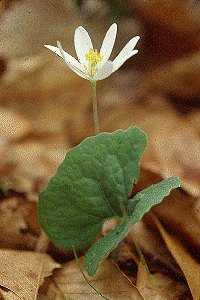
 Pushing up through the earth and brown leaves of early spring, the tightly rolled leaf of the bloodroot encloses a flower bud, keeping it safe from harm. As the leaf unrolls the flower stem pushes the bud up beyond the leaf where it slowly swells into a blossom.
Pushing up through the earth and brown leaves of early spring, the tightly rolled leaf of the bloodroot encloses a flower bud, keeping it safe from harm. As the leaf unrolls the flower stem pushes the bud up beyond the leaf where it slowly swells into a blossom.Borne on this leafless stalk, the solitary flower has 8 to 12 white petals about one inch long surrounding a center of bright yellow stamens. Like many spring flowers, it closes at night and even stays closed on especially gloomy days. It is extremely fragile and the petals soon drop making it useless for picking. The single leaf continues to enlarge after the petals fall, and remains green well into summer, when it then disappears.
This perennial is a member of the poppy family, Papaveraceae. One of the characteristics of the poppy family is the production of colored juices. This juice is the source of opium in the opium poppy. In bloodroot, the juice is red and poisonous. It makes a lasting stain and thus a good dye which the Indians utilized.
The rootstock that gives this plant its name is about one-half inch thick and up to four inches long. It contains a bright red-orange juice said to have been used on sugar as a cough remedy; but the plant is definitely poisonous if eaten and a skin irritant to some.
Bloodroot is becoming rare in Alabama. Collect fresh seed and sow at once. If allowed to dry, the percentage of germination will be low. At any rate, seed will not germinate until the following spring.
It can be transplanted at any time and will grow in most soils but is best moved when the much expanded leaf is dying down. Space plants about six inches apart and plant the rhizome one-half inch to one inch deep.
Bloodroot grows best in a sheltered woodland with bright sun in the early spring and shade when the leaves come out on the hardwood trees. It transplants easily, propagates readily, and if once established will make delightful patches in a few years.
